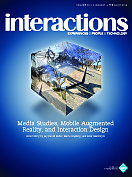Authors:
Gerrit van der Veer
The population of China is larger than any other country in the world. China also has the world's largest user population of mobile phones and the Internet, as well as the largest production of mobile phones and PCs. The Chinese ICT industry shows a growing interest in usability, and interdisciplinary research has become a driving force in development. Several major businesses apply state-of-the-art techniques such as contextual inquiry, cultural probes, ethnographic methods, and UX design. We know there is the Chinese Ergonomics Society, with 450 members, and the Chinese Psychological Society, with 8,000 members, and there exists a large and active HCI group that regularly attracts around 1,000 practitioners and students at its events. Zhengjie Liu, SIGCHI's adjunct chair for the developing world, is one of the champions here.
Yet in SIGCHI we do not know too much about the state of education in our field in China. So far we have identified 10 to 15 master's programs or specializations featuring HCI, mainly in universities in China's major cities. About half of them are based in computer science, mostly focused on HCI technologies. Three are based in psychology faculties, and the others are in design or industrial engineering. The curriculum of the Sino-European Usability Center in the Faculty of Computer Science at Dalian Maritime University seems to be the only one with a clear focus on UX and interaction design. Zhengjie is the head of the Center, and he invited me to spend some time with his group to learn more about and reflect on HCI education in his world.
I embarked on a full-blown ethnographic study: living on campus for six weeks, eating with the students and dining with the teachers, attending classes and teaching, and reaching the level of VIP cardholder at the student coffee shop. Communication in English was without major problems. When students email the group, they use English since in each year's group (five to 10 students) there are one or two international students. Some international students stay for the full master's degree, others for a semester. In addition, there are some six to eight Ph.D. students, with one or two new each year. Visiting professors are a regular addition to the teaching staff.
The background of the students is an interesting mix: Half enter with a bachelor's in computer science; others are from design, marketing, linguistics, mathematics, or even meteorology (I could not find out why this last one changed her mind, though). As a group they showed a creative approach to applying new methods and considering new ideas, keeping their design context in mindafter all, their clients, as well as the intended users, are currently living in a quickly developing and changing world.
I discovered that only one year of this master's curriculum is devoted to regular computer science: software engineering, computer networks, artificial intelligence, databases, and statistics. The other year and a half is devoted to typical HCI courses, to usability engineering, and to the master's thesis that has to be defended at the end of the program. In this large HCI part, students get a variety of practical training, including application of usability measures like the SUMI and SUS, observations in a usability lab, and car-driver studies with a simulator. Some students spend six months in a university in another country; some do a two-month internship in industry.
During my stay, more than half of the final-year master's students traveled to Beijing on a job-hunting trip, and others already had contracts to start work after they successfully defended their theses. Indeed there seem to be plenty of jobs for them in the Internet and mobile phone industries, and in banking. And when they start, they are well aware of international developments in HCI and of state-of-the-art tools and techniques.
Gerrit C. van der Veer
President, ACM SIGCHI
©2013 ACM 1072-5220/13/01 $15.00
Permission to make digital or hard copies of all or part of this work for personal or classroom use is granted without fee provided that copies are not made or distributed for profit or commercial advantage and that copies bear this notice and the full citation on the first page. To copy otherwise, to republish, to post on servers or to redistribute to lists, requires prior specific permission and/or a fee.
The Digital Library is published by the Association for Computing Machinery. Copyright © 2013 ACM, Inc.








Post Comment
No Comments Found